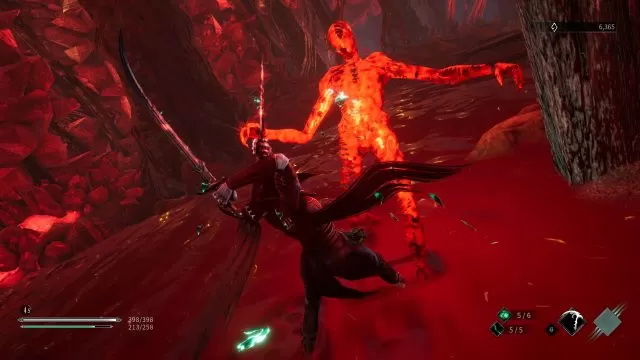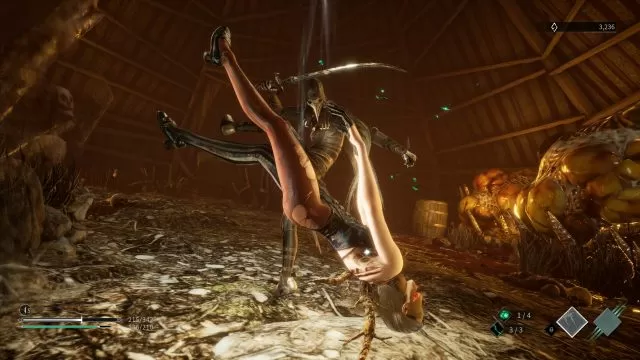Thymesia Review – Bloodborne Lite
PC gamers: we want Bloodborne!
Mom: we have Bloodborne at home.
Bloodborne at home:
They say that in capitalism, markets always correct themselves. PC audience wanted Bloodborne for a long time, but Sony, even if they shared some crown jewels such as Spider-Man, God of War, and Horizon, clutched its exclusivity firmly. The market forces rolled their sleeves and adjusted their hat; They got this, no worries. Bloodborne for PC is out of the question for now, but we can have Thymesia as a consolation prize. Let us hear the thundering yay!

Ambition to Imitate
Thymesia is a gothic Soulsborne that shares lots of visual and conceptual DNA with Bloodborne. The Kingdom of Hermes, once prosperous, had fallen into the abyss. The deadly plague devastated everything, but the official response proved even more harmful. The kingdom’s alchemists experimented with blood concoctions and accidentally unleashed the vile mutations. Corvus, an amnesiac, black-clad protagonist, found himself in the infected city, but after a brief confrontation with a powerful boss, woke up inside the Hunter’s dre… Philosopher’s Hill. There, he’ll talk with the mysterious doll girl, who will help him piece together his repressed history.
Budget Bloodborne

The “borrowing” is rather shameless but presumably within legal limits. Unfortunately, Thymesia almost completely fails in the finer points of world-building, both figuratively and literally. The bits and pieces of lore you’ll collect during the adventure are amateurishly written and paint a predictable picture. The fragments discussing “pure blood” and “vile blood” are particularly cringe-worthy due to the literal banditry of other people’s creative efforts. The environmental storytelling is also crude and devoid of subtlety present in every From software game. The game oozes ambition to imitate but stumbles at every step.
Compared to the sprawling, brilliantly designed city of Yharnam, here we have claustrophobia-inducing, maze-like levels accessed through Philosopher’s Hill. After you beat the boss at the end of each zone, you’ll unlock secondary missions. Those use the same general layout, but parts of the level are inacessible, funneling you through a (mostly) linear path to the end. Well, I suppose this is a budget-friendly way to extend the playtime. Creating new environments from scratch takes time, and time is money. Those alternative missions are also devoid of any random elements. Not only that we don’t get proper Yharnam equivalent, we also don’t get anything resembling chalice dungeons. You’d kinda expected those with all that design mirroring.
Fast-paced, Explosive Combat

The essential saving grace for Thymesia is fast-paced, explosive combat full of exciting ideas. Every enemy, including bosses, has two health bars; the first is “normal”, reduced by bashing them with saber attacks which slowly reveal the “wound “bar located under it. For wounds to become permanent, you must use claw or secondary weapon attacks and do it fast, lest they heal. So, you can’t rely on a singular, repetitive damage-dealing procedure; you must use intelligent, timed rotation between two or three types of attacks.
Apart from a few archer and magic-wielding mobs, Thymesia is a mostly melee-orientated game. Its blazing pace is due to the fact that neither normal nor claw attack nor dodging/parrying use stamina. The double-edged sword of you being able to attack like a hornet from hell is that bosses follow the same principle. Most normal, human-sized bosses are absolutely relentless in their attacks, offering nary a second of respite during the fights. The result is that those fights are physically taxing, requiring constant dodging, repositioning, and attack rotation. I have played most Soulsborne games to completion, but I never felt so spent after multiple attempts on an average boss. Want to burn some excess calories? Play Thymesia.
Secondary Weapons, Talent Builds…

Stamina, or energy, expends with special weapon attacks. Those weapons represent the plagued versions of standard melee armaments such as swords, knives, hammers, scythes, etc. They inflict different amounts of damage and, if sufficiently upgraded, add a beneficial effect on the player and/or status effect on the enemy (like temporary stagger). Scythe, for example, heals you with every swing that connects. Unlocking the secondaries takes time and effort, as their shards must be obtained by defeating mobs and bosses wielding the same weapons. Besides those shards and upgrade mats for the HP flask, there isn’t any loot in the classic sense.
Like in Sekiro, the primary weapon is set in stone. The trusty saber can’t be replaced, but you can augment it by unlocking the various talents. There are multiple efficient builds in Thymesia, but talent points are capped; after twenty-five or so levels, you only get a single stat upgrade after a ding. Fortunately, you can reset the talents if you pick something that proved pointless, such as parry-augmenting nodes. Parry in this game is abysmally bad, so for avoidance, I recommend taking the dodge talent route. Talents that replenish the energy for secondaries are also helpful, especially if you use them with HP restoring weapons, such as a scythe.
Is it Worth your Time?

There’s a significant contrast between sharp, exciting combat and the dullness of everything else in Thymesia. The derivative plot and poorly designed linear environments get tiresome pretty quickly. On the other hand, the game is reasonably priced, and there’s a fact that most players have managed to extract every molecule of content from Elden Ring by now. There aren’t many Soulsborne games floating around these days, and for that reason only, Thymesia deserves to be considered.
Highs
- Exciting, fast-paced combat with few original ideas.
Lows
- The story is full of elements shamelessly “borrowed” from Bloodborne.
- Poor level design and a limited number of environments.
- Lots of useless, dead ends in the talent trees.

